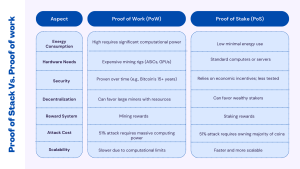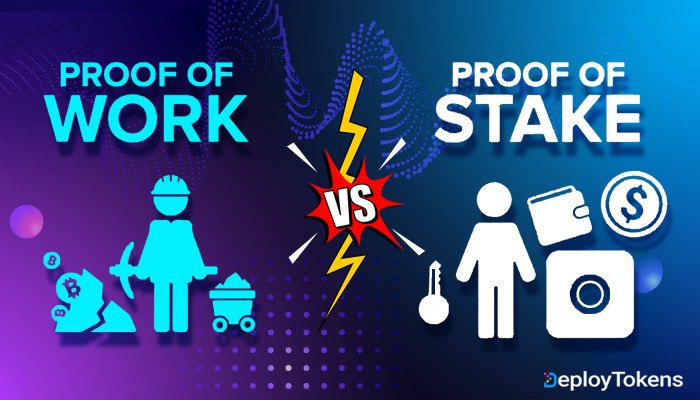The world of blockchain technology is evolving rapidly, and at the heart of this revolution lies a critical debate: Proof of Work vs. Proof of Stake. These two consensus mechanisms power some of the most popular cryptocurrencies, like Bitcoin and Ethereum, and understanding their differences is key to grasping the future of decentralized systems. If you’ve ever wondered, “What is PoW and PoS?” or “Is PoS better than PoW?”—you’re not alone. These questions are buzzing across the crypto community, and for good reason.
In this comprehensive guide, we’ll dive deep into the difference between Proof of Stake and Proof of Work, explore their strengths and weaknesses, and answer the burning question: Which is better—Proof of Work or Proof of Stake? Whether you’re a blockchain enthusiast, a developer at DeployTokens, or just curious about the tech behind your favorite crypto, this blog will break it all down in a professional yet easy-to-understand way. Let’s get started.
What is Proof of Work (PoW)?
Proof of Work (PoW) is the original consensus mechanism that powers Bitcoin and many other early blockchains. Introduced by Satoshi Nakamoto in 2008, PoW is often described as the backbone of cryptocurrency security. But what is Proof of Work (PoW) exactly?
In simple terms, PoW requires miners to solve complex mathematical puzzles using computational power. This process, known as mining, validates transactions and adds new blocks to the blockchain. Miners compete to find the solution, and the first one to succeed earns a reward usually in the form of cryptocurrency like BTC.
How Does Proof of Work Work in Blockchain?
- Miners use powerful hardware (like GPUs or ASICs) to perform billions of calculations per second.
- Once a puzzle is solved, the solution (or “proof”) is shared with the network.
- Other nodes verify the solution, and if valid, the block is added to the chain.
- The miner gets rewarded, and the cycle repeats.
This system ensures security by making it computationally expensive and time-consuming to attack the network. However, it’s not without its flaws more on that later.
What is Proof of Stake (PoS)?
Proof of Stake (PoS) emerged as an alternative to PoW, aiming to address some of its inefficiencies. Unlike PoW, PoS doesn’t rely on energy-intensive mining. Instead, it uses a staking model where validators are chosen to create new blocks based on the amount of cryptocurrency they “stake” (lock up) as collateral.
Ethereum, for example, transitioned from PoW to PoS in 2022 with its Ethereum 2.0 upgrade, marking a significant shift in the blockchain world. But what is Proof of Stake vs. Proof of Work in practical terms?
How Does Proof of Stake Work?
- Participants stake a certain amount of cryptocurrency (e.g., ETH) in a wallet.
- Validators are selected pseudo-randomly, with higher stakes increasing the chances of being chosen.
- The chosen validator proposes a new block, which is then verified by others.
- Rewards are distributed based on the stake and network rules.
PoS is often praised for being more energy-efficient and scalable, but it too has its trade-offs. Let’s explore the difference between PoW and PoS in detail.
Proof of Work vs. Proof of Stake: Key Differences
The difference between Proof of Stake and Proof of Work boils down to how they achieve consensus, their resource usage, and their implications for security and decentralization. Here’s a detailed comparison:

Mining vs. Proof of Stake
A common question is: What’s the difference between mining and Proof of Stake? Mining (PoW) involves solving puzzles with hardware, while PoS replaces this with staking coins. Mining consumes vast amounts of electricity, whereas PoS is lightweight and eco-friendly.
Why is Proof of Work Better Than Proof of Stake?
PoW has its champions, and for good reason. Here’s why some argue why Proof of Work is better than Proof of Stake:
- Battle-Tested Security: Bitcoin’s PoW has never been hacked in over 15 years, proving its resilience. The sheer computational power needed for a 51% attack makes it prohibitively expensive.
- True Decentralization: While large mining pools exist, anyone with hardware can theoretically join the network, keeping it open to newcomers.
- Economic Incentives: Miners invest heavily in equipment, aligning their interests with the network’s long-term success.
However, the question “Why is PoW better than PoS?” often overlooks the energy issue. Bitcoin mining alone consumes more electricity than some countries, raising sustainability concerns.
Why is Proof of Stake Better Than Proof of Work?
On the flip side, PoS advocates have compelling arguments. Here’s why Proof of Stake is better than Proof of Work in many eyes:
- Energy Efficiency: PoS uses a fraction of the energy PoW does, making it a greener alternative. Ethereum’s switch to PoS cut its energy use by over 99%.
- Scalability: PoS networks can process transactions faster, addressing bottlenecks seen in PoW systems like Bitcoin (7 transactions per second).
- Lower Entry Barrier: No need for expensive hardware—just stake your coins and participate.
So, why is PoS better than PoW? It’s about sustainability and future-proofing blockchain for mass adoption.
Is Proof of Stake Better Than Proof of Work?
The question “Is Proof of Stake better than Proof of Work?” doesn’t have a one-size-fits-all answer. It depends on your priorities:
- If security and decentralization are your focus, PoW might edge out due to its proven track record.
- If sustainability and scalability matter more, PoS is the clear winner.
For example, a no-code platform focused on token creation and deployment, might lean toward PoS for its efficiency in building scalable blockchain solutions.
FAQ: Addressing Common Concerns
Let’s tackle some micro-level questions that often arise in the PoW vs. PoS debate:
What is the Difference Between PoW and PoS in Blockchain?
At its core, PoW uses computational work, while PoS uses economic stake. This impacts everything from energy use to validator selection.
Is PoS Better Than PoW for Small Investors?
Yes, PoS lowers the barrier to entry. You don’t need costly mining rigs—just enough coins to stake.
1. Why is Proof of Work Better for Security?
PoW’s security stems from its high attack cost. A 51% attack on Bitcoin would cost billions, deterring bad actors.
2. Why is Proof of Stake Better for the Environment?
PoS eliminates the need for energy-hungry mining, aligning with global sustainability goals.
3. Is Proof of Work Better Than Proof of Stake for Decentralization?
It’s debatable. PoW can centralize around mining pools, while PoS can favor wealthy stakers. Neither is perfect.
4. What is PoW and PoS in blockchain?
PoW uses mining to validate transactions, while PoS relies on staking coins.
5. What is the difference between PoW and PoS?
PoW is energy-intensive and hardware-based; PoS is lightweight and stake-based.
6. Is Proof of Stake better than Proof of Work?
It depends—PoS excels in efficiency, while PoW shines in security.
7. Why is Proof of Work better than Proof of Stake?
PoW’s proven security and high attack cost make it a trusted choice.
8. Why is Proof of Stake better than Proof of Work?
PoS is eco-friendly and scalable, ideal for modern blockchains.
Which is Better: Proof of Work or Proof of Stake?
So, which is better—Proof of Work or Proof of Stake? The answer hinges on the use case:
- Bitcoin thrives on PoW because its priority is uncompromised security and decentralization.
- Ethereum embraced PoS to scale and reduce its carbon footprint, appealing to a broader audience.
The Future of Blockchain: PoW, PoS, or Something Else?
As of 2025, the blockchain landscape is still shifting. PoW and PoS aren’t the only players hybrids like Delegated Proof of Stake (DPoS) and emerging mechanisms like Proof of Space are gaining traction. The real question is: What is PoW and PoS in blockchain’s long-term evolution?
- PoW will likely persist in legacy systems like Bitcoin, where security trumps all.
- PoS is poised to dominate new projects, especially those prioritizing efficiency and eco-friendliness.
For businesses like DeployTokens, adopting PoS could accelerate growth by aligning with modern blockchain trends.
Conclusion: Proof of Work vs. Proof of Stake
In the battle of Proof of Work vs. Proof of Stake, there’s no universal victor. PoW offers unmatched security and a proven model, while PoS brings efficiency and scalability to the table. Whether you’re asking “What is Proof of Work vs. Proof of Stake?” or “Why is PoS better than PoW?”, it’s clear both have a role in blockchain’s future.
For token creators at DeployTokens or crypto enthusiasts exploring the space, understanding these mechanisms is crucial. The choice between PoW and PoS depends on your goals—security or sustainability, decentralization or speed. What do you think? Share your thoughts below, and let’s keep the conversation going.
